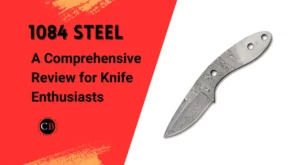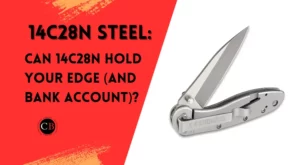If you’ve ever studied oil-hardening tool steel, you’ve probably heard of O1 tool steel. Many knife manufacturers make knives from it, but, is O1 steel good for knives?
Ever held a blade so sharp it could shave paper blindfolded? That’s the magic of O1 steel, a high-carbon wonder loved by knife enthusiasts. But is it right for you? Let’s dive into the pros and cons to help you decide!
Table of Contents
What is O1 tool steel?
O1 is an oil-hardening, cold-rolled tool steel of the lower price segment and belongs to the O-group steels (O1, O2, O6, O7). It is a very popular steel used by knifemakers of individual knives as well as in mass production. O1 tool steel is commonly used for cutting tools such as knives and blades. It is also known by the designations K460 (Bohler) as well as 1.2510.
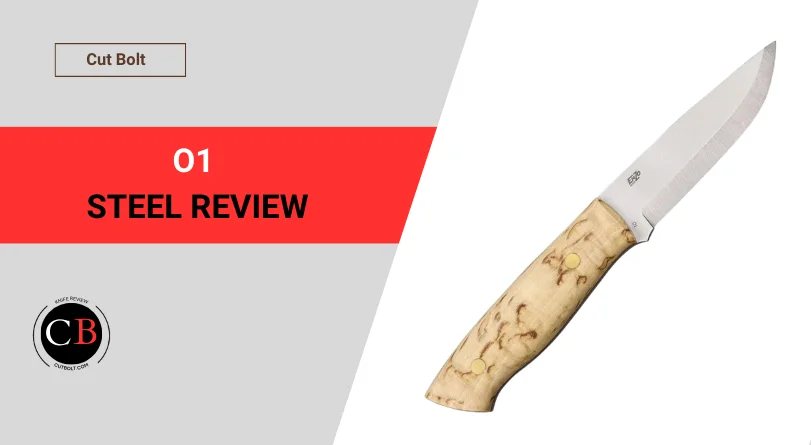
O1 tool steel chemical composition
| Element | Portion | Effect |
| Chromium | 0.6% | Improves wear resistance, heat resistance and scale resistance. It increases tensile strength because it acts as a carbide former. Use of rust-free or stainless steel, as it increases corrosion resistance from a mass proportion of 12.2%. Reduction in weldability. |
| Carbon | 1.0% | Increasing hardness and tensile strength. In larger quantities, increase in brittleness and reduction in forgeability and weldability. |
| Manganese | 1.4% | Improves hardness and tensile strength. |
| Nickel | 0.3% | Nickel increases tensile strength and yield strength. From 8% increase in corrosion resistance. |
| Phosphorus | 0.03% | Increases tensile strength, hardness and corrosion resistance but also brittleness. |
| Sulfur | 0.03% | Increases machinability but also brittleness. |
| Silicon | 0.5% | Improves strength. |
| Vanadium | 0.3% | Increasing hardness, increasing wear resistance and improving tempering resistance. |
| Wolfram | 0.6% | Increase in heat strength, tempering resistance and wear resistance at high temperatures up to red heat. |
O1 tool steel is considered a low-end steel with high carbon and manganese content, which is characterized by high hardness and wear resistance.
Does O1 rust, or is O1 a stainless steel?
O1 tool steel is neither a rust-free steel nor a stainless steel. O1 is not a stainless steel because its sulfur and phosphorus content (so-called iron companion) exceeds 0.025% (see here).
To be considered rust-free, it would require a chromium content of at least 10.5 – 13% dissolved in austenite or ferrite, depending on the definition.
What is the hardness (HRC) of O1 tool steel?
The hardness of O1 ranges from 57-65 on the Rockwell C scale, depending on the tempering, and is 62 HRC on average.
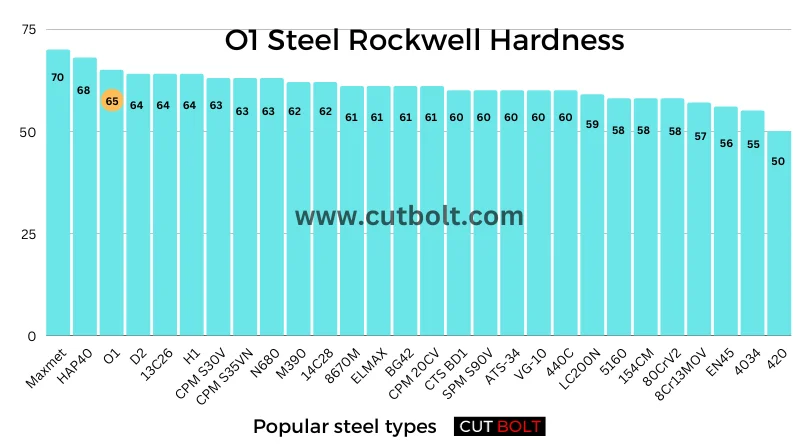
Properties of O1
According to its chemical composition and its achievable hardness, 01 tool steel offers the following properties:
- Edge retention: O1 offers good edge retention due to its hardness.
- Corrosion resistance: Corrosion resistance: O1 steel is a high-alloy steel (it contains only 0.6% chromium) and therefore not rustproof. To avoid corrosion, the steel must be kept as dry as possible and maintained with appropriate grease.
- Wear resistance: O1 has quite a lot of components such as vanadium, manganese and carbon, which make it a very hard steel with great wear resistance.
- Sharpenability: O1 is very easy to sharpen and can also be easily processed with simple abrasives. It can be ground very finely and has excellent abrasion resistance, toughness and sharpness.
- Machinability: O1 tool steel has excellent machinability.
- Toughness: O1 is very balanced in terms of toughness and hardness. It has great toughness, which is mainly given by the nickel.
- Patina: O1 is susceptible to corrosion. But this also means that over time an individual patina will develop on the blade, which will be appreciated by many knife lovers. Through contact with different foods or other cut goods, the steel will usually turn into different shades of gray, but also brown, yellowish, blue and purple. The patina can be quickly removed from the steel with a polishing paste if it is not desired!
My opinion: Is O1 steel good for knives?
Yes, O1 tool steel is a good knife steel with decent edge retention, great wear resistance, good hardness and toughness. However, its corrosion resistance is not very high. Therefore, potential buyers of an O1 knife should be prepared to invest a bit in maintenance – drying and oiling after use, especially after using the knife in a humid environment is mandatory!
All in all, I think it is worth owning/making a knife from this low-end tool steel when you compare the price and performance of the O1 tool steel.
Is O1 steel for you?
- Thrill seeker: Crave a razor-sharp companion for the wild? O1’s your buddy.
- Low-maintenance? Pass. Stainless steel might be a better fit.
- Knife aficionado: Ready to pamper your blade? O1’s a rewarding challenge.
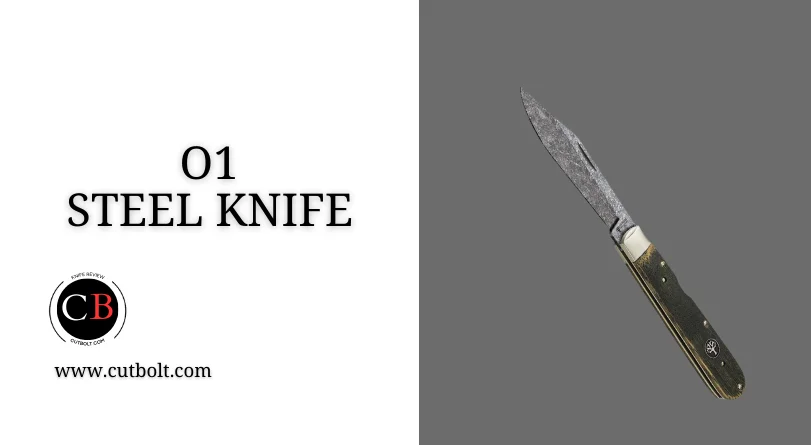
Related: Is N690 steel worth the money?
O1 Steel compared to other steels
Despite its fine carbide structure, O1 does not have particularly high toughness compared to other steels. For example, A2 is probably the best counterpart to O1 in terms of industrial use. But it is air-hardened instead of oil-hardened. However, despite O1’s fine carbide structure, A2 has both better toughness and abrasion resistance than O1. The sharpenability of O1 is significantly better in comparison.
O1 vs. A2 Steel
While A2 steel boasts better corrosion resistance than O1, the latter excels in edge retention, making it a preferred choice for many knife enthusiasts. O1’s finer grain structure gives it the edge in terms of ease of sharpening, enhancing its appeal for users.
The toughness of O1 steel offers a distinct advantage in heavy cutting applications, positioning it as a reliable option for demanding tasks. Despite A2’s resilience to corrosion, the overall performance and maintenance ease of O1 steel continue to make it a top contender in the realm of knife materials.
O1 vs. D2 Steel
When comparing O1 steel to D2 steel, it’s clear that each has its own strengths and advantages. While D2 boasts exceptional wear resistance, O1 excels in retaining a sharper edge over time, making it a preferred choice for those prioritizing edge retention.
Despite requiring more frequent sharpening compared to D2, O1 offers superior toughness for demanding tasks, positioning it as a reliable option for heavy cutting applications. Although D2 exhibits an edge in corrosion resistance, especially in high-moisture environments, many users appreciate the balance of performance and edge retention that O1 steel provides, making it a top contender for versatile knife usage.
O1 Tool Steel equivalents
For a hard tool steel that has high edge retention, toughness and wear resistance, but rusts easily, I would immediately go to AISI L6 – the chemical composition is very similar, but AISI L6 has a slightly higher nickel content for more toughness.
In principle, you can also throw D2 or A2 tool steel into the room, but these are clearly superior to O1 steel, so you can’t really consider them equivalents.
Conclusion: Is O1 tool steel good for knives?
O1 steel is a proven, inexpensive tool steel that is ideal for the production of knives and other tools due to its combined properties of toughness, hardness and abrasion resistance. It is characterized by a fine grain structure and can be hardened very well. The steel has a long service life and good edge retention and can be sharpened using simple means. Although it is not stainless steel, it has been proven in tool and knife making for decades and offers good performance at an affordable price.
However, I must also remind you of the poor corrosion resistance, which means that you have to give the knife more care. I would not recommend it to hunters, divers, sailors, or chefs. These user groups are better served by a tool steel with high corrosion resistance, such as CPM 3V. It is in about the same price range and has great corrosion resistance and toughness.


